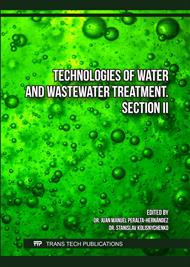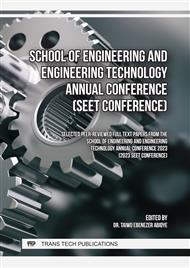[1]
G. Konapala, A.K. Mishra, Y. Wada, E. Michael, M.E. Mann, Climate change will affect global water availability through compounding changes in seasonal precipitation and evaporation, Nat. Commun. 11(2020) 3044 3053
DOI: 10.1038/s41467-020-16757-w
Google Scholar
[2]
S.L Zubaidi, S. Ortega-Martorell, P. Kot, R.M. Alkhaddar, M., Abdellatif, S.K. Gharghan, M.S. Ahmed and K.A. Hashim, A Method for Predicting Long-Term Municipal Water Demands Under Climate Change. Water Resour. Manag. 34 (2020) 1265–1279.
DOI: 10.1007/s11269-020-02500-z
Google Scholar
[3]
R. Devi and R.P. Dahiya, COD and BOD removal from domestic wastewater generated in decentralised sectors, Bioresour. Technol. 99 (2008) 344–349
DOI: 10.1016/j.biortech.2006.12.017
Google Scholar
[4]
Y. Smaoui, J. Bouzid, N. Ayadi, S. Mseddi, S. Sayadi, Evaluation of influence of coagulation/flocculation and Fenton oxidation with iron on landfill leachate treatment, Environ. Prot. Eng. 45 (2019) 139–153.
DOI: 10.37190/epe190111
Google Scholar
[5]
A.H Amran, N.S. Zaidi, A. Syafiuddin, L.Z. Zhan, M.B. Bahrodin, M.A. Mehmood, and R. Boopathy, Potential of Carica papaya Seed-Derived Bio-Coagulant to Remove Turbidity from Polluted Water Assessed through Experimental and Modeling-Based Study, Appl. Sci. 11 (2021) 5715
DOI: 10.3390/app11125715
Google Scholar
[6]
C.Y. Teh, T.Y. Wu, J.C. Juan, Optimization of agro-industrial wastewater treatment using unmodified rice starch as a natural coagulant, Ind Crops Prod. 56 (2014)17-26.
DOI: 10.1016/j.indcrop.2014.02.018
Google Scholar
[7]
Hendrawati, I.R. Yuliastri, Nurhasni, E. Rohaeti, H. Effendi, L.K. Darusman, The use of Moringa oleifera seed powder as coagulant to improve the quality of wastewater and ground water, IOP Conf. Ser. Earth Environ. Sci. 31(2016) 012033.
DOI: 10.1088/1755-1315/31/1/012033
Google Scholar
[8]
J. Saravanan, D. Priyadharshini, A. Soundammal, G. Sudha, K. Suriyakala, Wastewater Treatment using Natural Coagulants, SSRG int. j. civ. eng. 4, 3(2017) 37 – 39
Google Scholar
[9]
N. Li, Y. Hu, Y. Z. Lu, R.J. Zeng, G.P. Sheng, Multiple response optimization of the coagulation process for upgrading the quality of effluent from municipal wastewater treatment plant, Sci. Rep. 6 (2016) 1–13
DOI: 10.1038/srep26115
Google Scholar
[10]
A.H. Amran, N.S Zaidi, K. Muda, K, L.W. Loan, L.W., Effectiveness of Natural Coagulant in Coagulation Process: A Review, Int. J. Eng. Technol. 7 (2018) 34- 37
DOI: 10.14419/ijet.v7i3.9.15269
Google Scholar
[11]
S. Nimesha, C. Hewawasam, D.J. Jayasanka, Y. Murakami N Araki, N. Maharjan, Effectiveness of natural coagulants in water and wastewater treatment, Glob. J. Environ. Sci. Manag. 8,1(2022) 101-116.
Google Scholar
[12]
S. Verma, I. Mehraj, A Jain, A.P Ray, Application of Zia Mays and Cucorbita Pepo as Natural coagulants for Purification of River Water. Int. j. innov. sci. eng. technol. 2, 5 (2015) 693-696.
Google Scholar
[13]
W. L.Ang, A.W. Mohammad, State of the art and sustainability of natural coagulants in water and wastewater treatment, J. Clean. Prod. 262 (2020) 1-18.
Google Scholar
[14]
S. Zaman, A. Begum, K.S. Rabbani, L. Bari, Low cost and sustainable surface water purification methods using Moringa seeds and scallop powder followed by bio-sand filtration, Water Sci. Technol.: Water Supply 17, 1(2017) 125-137.
DOI: 10.2166/ws.2016.111
Google Scholar
[15]
J. Mo, Q. Yang, N. Zhang, W. Zhang, Y. Zheng, Z. Zhang, A review on agro-industrial waste (AIW) derived adsorbents for water and wastewater treatment, J. Environ. Manag. 227(2018) 395-405.
DOI: 10.1016/j.jenvman.2018.08.069
Google Scholar
[16]
O.M. Makanjuola, J.O Makanjuola, Proximate and selected mineral composition of ripe pawpaw (Carica papaya) seeds and skin, J. Sci. Innov. Res. 7, 3(2018)75- 77.
DOI: 10.31254/jsir.2018.7304
Google Scholar
[17]
M. Chávez-Pesqueira, J. Núñez-Farfán, Domestication and genetics of papaya: A review. Front. ecol. evol. 5 (2017) 1–9
DOI: 10.3389/fevo.2017.00155
Google Scholar
[18]
J. Schwartz, R. Levin, R., Goldstein, Drinking water turbidity and gastrointestinal illness in the elderly of Philadelphia, J Epidemiol Community Health 54 (2000) 45–51.
DOI: 10.1136/jech.54.1.45
Google Scholar
[19]
E. Siswoyo, D. S. Dian Suryani Tanjung, M.J.H. Jalaly, Development of Natural Coagulant for Turbidity Removal Created from Marine Product Solid Waste. IOP Conf. Ser. Earth Environ. Sci. 799 (2021) 012038
DOI: 10.1088/1755-1315/799/1/012038
Google Scholar
[20]
APHA, Standard Methods for the Examination of Water and Wastewater. 21st ed. Washington, D.C.: American Public Health Association (2005)
Google Scholar
[21]
World Health Organization (WHO), Guidelines for drinking-water quality, fourth edition. Information on http://whqlibdoc.who.int/publications/2011/9789241548151_eng.pdf.
Google Scholar
[22]
G. Duithy, C.J. Arya, Coagulation Performance Evaluation of Papaya Seed for Purification of River Water, IJLTEMAS VII, I (2018) 30 – 66
Google Scholar
[23]
E. Siswoyo, I. Qoniah, P. Lestari, J.A., Fajri, R.A. Sani, D.G. Sari, T. Boving, Development of a floating adsorbent for cadmium derived from modified drinking water treatment plant sludge, Environ. Technol. Innov.14 (2019) 1-9.
DOI: 10.1016/j.eti.2019.01.006
Google Scholar
[24]
United States Environmental Protection Agency (USEPA), Effects of Acid Rain – Materials. Information on http://www.epa.gov/acidrain/effects/materials.html.
Google Scholar
[25]
T.O. Olabanji. O.M. Ojo. C.G. Williams. A.S. Adewuyi, Assessment of Moringa oleifera Seeds as a Natural Coagulant in Treating Low Turbid Water, FUOYEJET 6(4) (2021) 397-400.
DOI: 10.46792/fuoyejet.v6i4.702
Google Scholar
[26]
A. Sundaresan, N. Anu, (2016). Feasibility of Natural Coagulant for the Treatment of Dairy Wastewater, Int. J. Eng. Res.7, 4 (2016) 245-249
Google Scholar
[27]
A.G. Mann, C.C. Tam, C.D. Higgins, R.C. Rodrigues, The association between drinking water turbidity and gastrointestinal illness: a systematic review, BMC Public Health.7,256(2007)1-7.
DOI: 10.1186/1471-2458-7-256
Google Scholar



